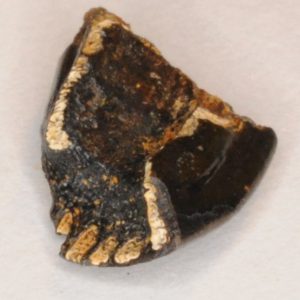NJfossils.com
"Fossils aren't a hobby, they're a lifestyle."Ratfish (Ischyodus bifurcatus)
Age – Late Cretaceous; Commonality – less common, Size – crushing plates: ¼ – 3 ½ inches, fin spines: ~3-6 inches (when complete)
The ratfish belonged to the subclass Holocephali of the class Chondrichthyes. They are cartilaginous fish that are sort of on the border between the sharks and fish.
They possess three types of bony crushing plates. They possessed two palatine crushing plates on the roof of their maxilla. They also possessed two vomerine plates at the front of the maxilla; these plates look similar to the incisors of a rodent. The mandible possessed two mandibular plates. Each plate was mostly bone with spots on the crushing surface containing tritors. Most of the crushing occurred on the tritors. Tritors are spongy-looking rows of calcified cartilage. The tritors are almost always fossilized with a yellow color. The mandibular and palatine plates are found much more frequently than the vomerines. The ratfish possesses a single fin spine which is located in front of the anterior dorsal fin. The spine contained venom and was used to ward off predators. The spine is flattened laterally and possesses fine striations and growth cracks. The trailing edge has a double row of denticles and is slightly hollow. The spines are slightly curved toward the posterior edge, although not as much as Hybodont spines.
Ratfish had cephalic claspers just like Hybodont sharks did, but they did not fossilize because they are not mineralized like Hybodont claspers. Information from Al Dente on TheFossilForum.
Palatine Mouth Plates
A complete right palatine mouth plate. There were two palatine mouth plates located on the maxilla. Note the presence of the four tritors and the enameled ledge. Palatine mouth plates are the easiest to find complete.
Mandibular Mouth Plates
A large left mandibular. This type of mouth plate was located on the mandible (two on either side).
Vomerine Mouth Plates
Fin Spine Fragment
Ratfish fin spine sections differ from Hybodont fin spine sections in that they possess a double row of tubercles on the trailing edge and don’t have striations on the sides.
















